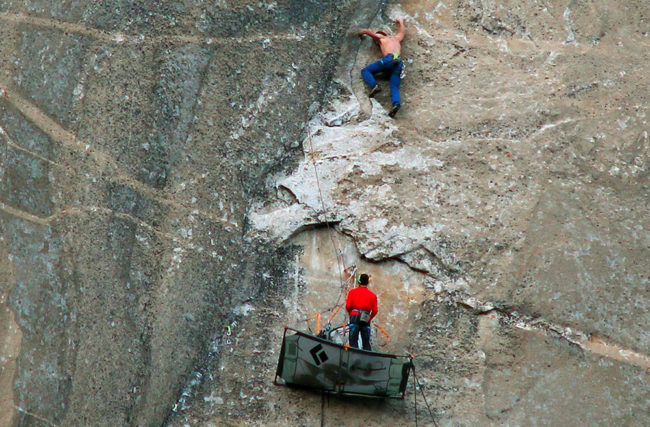
Update at 6:46pm ET:
Additional Information:
A photo posted by National Geographic (@natgeo) on Jan 14, 2015 at 5:29pm PST
On their 19th day of climbing, Tommy Caldwell and Kevin Jorgeson reached the top of El Capitan in California’s Yosemite National Park at 3:25 p.m. PT. The Los Angeles Times reports the climbers’ families were waiting for them at the summit. From The New York Times:
“After Caldwell hugged his wife and Jorgeson hugged his girlfriend, they were given sparkling wine. Jorgeson sprayed his. ‘That’s the first shower you’ve had in a while,’ Caldwell’s wife, Rebecca, said.”
Our orginial post continues:
Tommy Caldwell and Kevin Jorgeson are close to finishing one of the most difficult climbs in the world. Since Dec. 27, the duo has been free-climbing the sheer, southeastern face of El Capitan in California’s Yosemite National Park. Free-climbing means the two are using just their hands and feet to scale the nearly 3,000-foot wall — ropes are used only to break a fall.
If they make it, they’d be the first to successfully free-climb the Dawn Wall.
The New York Times has been following the ascent and reported Wednesday that:
“The crowd is growing atop El Capitan on a cloudless day. The view across Yosemite Valley and over the top of Half Dome leads to the snowy peaks of the Sierra Nevada. The top of El Capitan is not flat, so there will be no cartoonlike arrival — no hand appearing on the ledge from the abyss below. The vertical wall has no sharp edge at the top, but gives way to a steep slab of granite, sprinkled with crumbling rocks and small pines and shrubs. A dropped ball 100 yards from the cliff would bounce and roll downhill and then plunge out of sight. The climbers are expected to finish the last pitch and perhaps scramble or crawl the last few feet to their awaiting friends and families.”
As NPR’s Serri Graslie reported last week, the two men told All Things Considered that they’ve been preparing for the climb for some time:
“Caldwell, 36, and Jorgeson, 30, have spent years scaling different parts of the wall to place anchors and learn the route. Jorgeson compares it to conquering individual stages of the Tour de France.
” ‘Some stages are harder that you can actually climb at the time, so you really have to work it out,’ Jorgeson says. ‘We’ve been working on each of these stages and climbing ‘pitches’ … broken up by rope lengths. Our ropes are about 200 feet long so the pitches are obviously 200 feet long or less.’ ”
A support team also is making the climb, bringing batteries, food and other supplies, as well as taking photos and videos. Caldwell and Jorgeson also have been tweeting throughout their ordeal.
To anyone writing about #dawnwall, this is not an effort to “conquer.” It’s about realizing a dream.
Since Caldwell and Jorgeson are using their hands and feet for the ascent, special care must be applied to their hands, especially. Caldwell told National Geographic: “I wake up twice a night and reapply lotion to my hands. We sand our fingertips to keep them smooth.” And Jorgeson said he’s taped his hands several different ways.
The Times reports that Jorgeson and Caldwell have slept on the side of the El Capitan wall as they climb it:
“At some … resting spots the team must sleep. From those anchors, they hang nylon tents built on aluminum frames. These “portaledges” are really quite comfortable. The trick is making one’s anchor safe enough that sleep is possible. I liken it to investing. Just as one must invest one’s money safely enough to sleep at night, one must build enough of an anchor to sleep with ease on a big wall… They carry or haul all of this equipment, as well as food and water, with them as they progress up the wall.”
Jorgeson’s girlfriend, Jacqui Becker, told the San Jose Mercury News that she’s taken her first climbing lesson this week so that she can greet the pair at the summit. Becker says Jorgeson and Caldwell are more than just daredevils:
“To call them thrill seekers is to minimize the profundity of their passion and commitment,” Becker says. She adds, “There is absolutely nothing thrilling about spending six years hauling thousands of pounds of gear up and down a mountain in freezing temperatures. There is nothing thrilling about leaving loved ones to tackle a distant dream. There is nothing thrilling about rehearsing and practicing and studying the same holds over and over until you dream them.”
9(MDEwMjQ0ODM1MDEzNDk4MTEzNjU3NTRhYg004))
Free-Climbers Make It To Summit Of Yosemite’s El Capitan